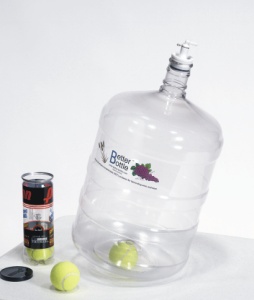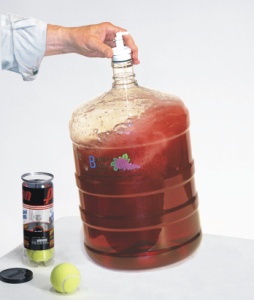problem with that is that it runs the risk of contamination from opening the carboy then jabbing it with a spoon. besides i don't have a spoon small enough to fit through the neck of the carboy or with a long enough handle to reach the fruit.
Well the handle of a plastic stirring paddle would do the job just as easily. If you've sanitised it, it's possible, though unlikely, that you'll introduce spoilage organisms (see below)
as far as being gentle when swirling i don't see why. the head space is totally full of CO2 so its not like i'm going to oxidize it.
Ok, so on the face of it, that'd make sense, but it's about meads (and other alcoholic brews for that matter) and the way that CO2 which is currently in solution in the ferment, is released.
Imagine you've shaken the hell out of a bottle of coke or something carbonated like that, but then put it back in the fridge for a couple of hours.
When you come to open it, it starts to fizz/foam, but there's a slight delay before it goes batsh1t and erupts out of the top.
It can be (not necessarily) similar with a ferment, you can give it a gentle swirl and the movement is enough to re-incorporate the fruit into the liquid part, without causing mead fountains. While you could easily be just a little bit less gentle and it's enough to cause the CO2 to come out of solution and foam like hell, coming out the top or through the airlock etc.
You've already shown that you're thinking on the right lines by questioning the use of a spoon/paddle/whatever and the potential for introducing spoilage organisms, which it a good way to be thinking (though you'd still be in the same position when racking/syphoning/bottling etc.... see where I'm going ???), so why not just be gentle with the ferment and swirl it enough just to mix the fruit back in. The idea of the tennis ball trick from BB is just as valid with glass, not that you're likely to get stress cracks but the weight on the tennis ball will allow enough clearance for you to be able to swirl the carboy in a circular motion enough to get the fruit pulp moving back into the liquid, as it should disturb enough of the CO2 in the fermenting part of the fruit to allow it to sink again - the CO2 coming out, as usual through the airlock.
Don't forget, CO2 is (apparently) a "heavier than air" gas, so unless you're racking from one container to another (enclosed containers that is), either the active fermenting part or the natural de-gas of a finished ferment, is going to continue to produce CO2 just on top of the liquid providing a CO2 rich blanket of gas. It's the same reason why you'd normally reduce the airspaces in secondary or finished ferments. We don't have a chemical laboratory in our back pocket, so there's practically no way of measuring the CO2 content of the gas layer. It's just to be on the safe side.
Besides, meads and honey based ferments seem to be more resistant to oxidation than "normal" wines..... I think it's something to do with the properties of the honey........
good luck with the brew....
regards
fatbloke




